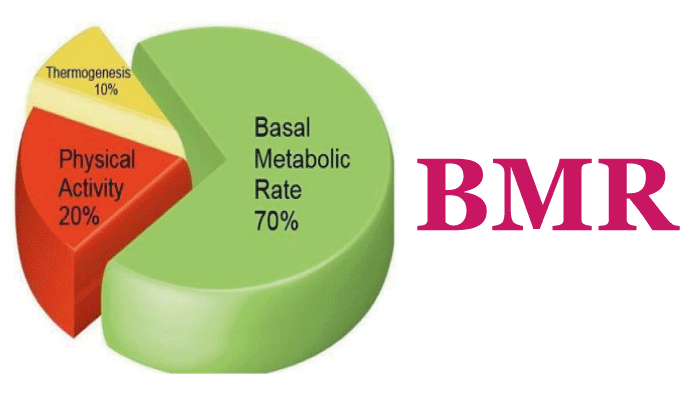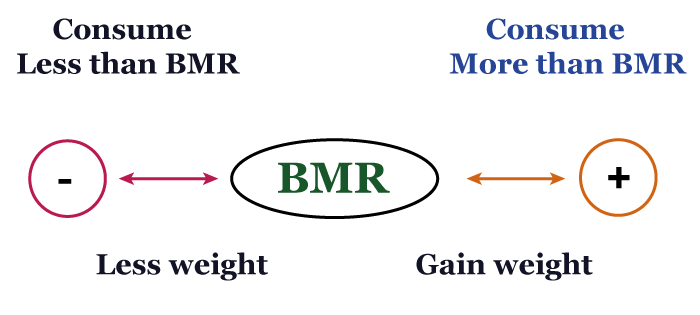BMR DefinitionThe minimum quantity of energy needed by a person's body to sustain their essential bodily processes while at rest is known as BMR or Basal Metabolic Rate. Basic physiological processes like breathing, circulation, and regulating body temperature require this energy to continue. About 60%-70% of the body's energy requirement is filled by the BMR of an individual and with the remaining amount going towards digestion and physical exercise. 
BMR differs from person to person, and their Age, gender, body shape, heredity, and others impact it. BMR declines with aging and is lower in women than in men because women generally have a greater percentage of body fat and a lower percentage of muscle mass than men. A greater BMR is also common in individuals with more muscle mass because maintaining muscle tissue takes more energy than maintaining fat tissue. BMR CalculationBMR can be calculated using several already identified techniques, such as indirect calorimetry, which calculates how much oxygen is ingested and carbon dioxide is generated while at rest by an individual. In the Harris-Benedict equation, A person's Age, gender, weight, and height are used to make estimates of their BMR, and bioelectrical impedance analysis assesses the person's body composition. It's crucial to comprehend BMR for several factors. On the primary level, BMI calculation can assist people in figuring out the number of calories they must consume daily to keep their weight in check. A person will acquire weight if they consume more calories than their BMR, while they will drop weight if they consume fewer calories than the BMI. The optimum number of calories to ingest each day to sustain exercise and preserve muscle mass can be determined using BMR, which can also be useful information for athletes and people seeking to better their fitness. This is followed widely by health professionals. Additionally, BMR is a technique commonly employed by medical experts worldwide to identify and manage various illnesses, such as obesity, diabetes, and thyroid problems in individuals. For instance, people with underactive thyroids may have reduced BMRs, resulting in symptoms like weight increase. Healthcare experts can identify the best course of treatment for these patients by measuring BMR. BMR is a crucial idea in the fields of diet and metabolism overall. It offers insightful data on the body's energy requirements and can be applied to create individualized diet and exercise regimens. People can take action to enhance their general health and wellness by knowing BMR. Researches Based on BMRResearchers have examined and debated the idea of Basal Metabolic Rate (BMR) for more than a century. Max Rubner, the first to suggest the same, was a German physiologist who said the existence of a living entity requires a minimal metabolic rate in the late 19th century. The investigation of metabolism and energy equilibrium in the human body was made possible thanks to Rubner's efforts. 
American physiologist Francis Benedict devised a technique for calculating BMR in the early 20th century that involved having individuals rest in a dimly lit chamber. At the same time, their oxygen intake and carbon dioxide generation were taken as parameters. The Harris-Benedict equation was created as a result of Benedict's research, which is still used to calculate BMR based on the Age, gender, weight, and height of a person. Efforts improved the field research of BMR during the 1930s and 1940s, which was a significant effort by German biochemist Otto Warburg. His studies concentrated on the function of enzymes in metabolic processes. His study on cellular respiration earned him the Nobel Prize in Physiology or Medicine in 1931 as a boon for his research in this field. History of Study of BMRThe BMR study gained importance in diet and obesity studies in the middle of the 20th century. Researchers have studied the relationship between BMR, body shape, and energy balance to understand better the mechanisms driving weight gain and reduction. In the 1970s and 1980s, with the development of Computed Tomography (CT) and Magnetic Resonance Imaging (MRI), researchers could better estimate body composition and understand the relationship between muscle mass, adipose mass, and BMR. This prompted the creation of novel formulae for calculating BMR that considered body proportion, Age, gender, and other variables. BMR research is still a crucial topic of study in the nutrition and metabolism disciplines. The research aims to understand better the genetic, hormonal, and contextual influences on BMR. Additionally, individuals are finding it simpler to track their energy consumption and make educated choices about their nutrition and physical exercise thanks to new techniques for calculating BMR, such as wearable technology and mobile applications. Various scientists and academics have contributed to the lengthy and intriguing history of the study of Basal Metabolic Rate (BMR), which spans several centuries. BMR is the term used to describe how many calories the body requires to maintain its functions while at rest. Through empirical observations, experimental measurements, and improvements in scientific methods, our understanding of BMR has developed over time. Early Observations: Research on BMR dates back to the beginning, when people began to observe how food intake, energy use, and general health interacted. Yet comprehensive studies on BMR started in the 19th and early 20th centuries thanks to the groundbreaking work of researchers like Carl von Voit, Max Rubner, and Francis G. Benedict. These scientists conducted early studies to assess the heat generation and oxygen consumption of animals and people at rest, offering early perceptions of the body's energy expenditure.
Our understanding of BMR is based on empirical data, experimental measurements, and mathematical models. Recognized as an essential part of energy metabolism, BMR is significant for several facets of health, including weight control, athletic performance, and clinical nutrition. BMR is frequently used as a starting point for calculating daily caloric needs, creating nutrition programs for specific people, determining metabolic health, and analyzing the results of interventions, including diet, exercise, and medical care. Finally, research on nutrition and energy balance, as well as the identification of variables influencing BMR, have all contributed to the development of the study of basal metabolic rate (BMR), which has a long and rich history. BMR is still a hot topic for research and analysis in the fields of metabolism and nutrition since it has significant consequences for many areas of health in today's world. BMR research has greatly advanced our knowledge of human physiology and energy metabolism, and it continues to be crucial in several health and well-being applications. As a result, it has grown to be a significant study area with applications in clinical settings, exercise science, and nutrition. Thus, it has become crucial. Additional Work
Carl von Voit's influential work from the 19th century may be credited with producing the first journal paper on BMR. His groundbreaking work laid the groundwork for understanding BMR and its function in human physiology and energy metabolism. Since then, BMR has been the subject of in-depth study and is still being actively researched in metabolism, nutrition, and health sciences. Hence, it has developed into a significant study area with real-world applications in several branches of science and medicine. Also, with time, it has grown in importance as a study area and continues to advance our knowledge of human physiology and metabolism. As an outcome, it has emerged as a crucial area of research with substantial consequences for many facets of health and well-being. To increase our understanding of BMR and its applications in the health sciences, it has become a key subject of exploration. As a result,
Practical Application of Using BMIThe BMR (Basal Metabolic Rate) is the minimal amount of energy needed by a person to sustain essential bodily processes like breathing, circulation, and temperature control when they are at rest. It is a crucial metric with several real-world uses in various industries.
BMR has real-world applications in nutrition, exercise, sports, and medicine. It is a useful metric that may be applied to enhance performance and health outcomes in many situations. BMR Evaluation StandardsThe bare minimum of energy needed to maintain essential biological activities at rest is known as BMR (Basal Metabolic Rate). Assessment of BMR is essential for identifying an individual's energy needs and assessing the success of various dietary and exercise treatments. Several guidelines must be followed while analyzing BMR for reliable and consistent findings.
Next TopicBotany- Definition
|
 For Videos Join Our Youtube Channel: Join Now
For Videos Join Our Youtube Channel: Join Now
Feedback
- Send your Feedback to [email protected]
Help Others, Please Share










